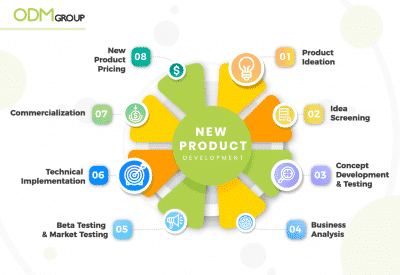Needless to say, launching a product or service successfully requires more than just a great idea or innovation. It demands a well-crafted and meticulously executed Go-To-Market (GTM) strategy.
But what is GTM strategy? In this blog, we will delve into the depths of what constitutes a Go-To-Market strategy, explore its fundamental components, understand its significance in the business, and offer actionable insights on how to implement a tailored GTM strategy.

What is a Go-To-Market Strategy?
At the heart of a triumphant product launch or market expansion lies the Go-To-Market (GTM) strategy—a guiding compass navigating enterprises through uncharted territory. But what is this enigmatic blueprint?
A GTM strategy isn’t just a plan; it’s the cornerstone of success. It’s the meticulously crafted roadmap that answers pivotal questions, ensuring your offering reaches the right audience, at the right time, in the right way.

This strategic enabler dives deep into the intricacies, grappling with questions crucial for success: What sets your product apart? Who craves its solutions? Where lies the ripest market? How do we spark desire?
A robust GTM strategy isn’t about ticking boxes; it’s about wielding foresight, shaping narratives, and anticipating needs. It’s the difference between a product lost in the market noise and one that resonates profoundly with its intended audience. In essence, it’s the alchemy that transforms potential into unparalleled success.
Identifying the Necessity for a GTM Strategy
The need for a GTM strategy isn’t a matter of choice but a strategic imperative woven into the fabric of market dynamics. It’s the compass steering endeavors in various scenarios: launching a new product in a familiar market, venturing into uncharted territories with an existing offering, or daringly stepping into completely new realms with untested creations.
When the market landscape shifts like sand dunes in the wind, adaptability becomes the bedrock of success. Dynamic conditions demand agility, foresight, and an astute understanding of the nuances within each market scenario. It’s about embracing the flux, strategizing amidst uncertainty, and pivoting swiftly when needed.
In today’s ever-evolving business arena, a static approach is akin to courting obsolescence. Flexibility isn’t just an option; it’s a requisite. Adaptation to the rhythm of changing markets is the song every successful GTM strategy dances to. It’s this very adaptability that transforms challenges into opportunities, ensuring the relevance and resonance of your offerings across diverse market landscapes.
Enhancing GTM Strategy with Promotional Initiatives
In addition to core elements like research, targeting, and messaging, integrating promotional initiatives like Giveaways, Gift with Purchase (GWP) promotions, and Point of Sale (POS) displays plays a pivotal role in amplifying the effectiveness of a Go-To-Market (GTM) strategy.

POS Displays in GTM Strategy:
Point-of-sale displays strategically positioned in physical retail spaces or even online platforms serve as silent salespersons, effectively communicating product benefits, enhancing brand visibility, and influencing purchase decisions at the crucial point of sale.
Integrating these promotional tactics within the broader GTM strategy fortifies the brand’s market penetration, engages customers, and creates memorable brand experiences, complementing the core strategy elements.

The Power of Promotional Products
Discover how leveraging promotional products can significantly bolster Go-To-Market (GTM) strategies. These tangible assets play a crucial role in reinforcing brand messaging, engaging consumers, and driving marketing initiatives across various industries. Explore industry-specific examples highlighting the effectiveness of these promotional tools.

Custom Tech Accessories:
Technology companies can distribute branded USB drives pre-loaded with product information or demos. This enables easy access to their offerings, facilitating faster product understanding for potential customers.

Reusable Water Bottles or Eco-Friendly Tote Bags:
Lifestyle or wellness brands can leverage eco-friendly products to emphasize their commitment to sustainability. These items, branded with their logo, serve as mobile advertisements while promoting their environmental values.

Branded Apparel: Promotional T-Shirts
Fashion or retail brands can use apparel as promotional products. These wearable items turn customers into walking billboards, showcasing the brand’s style and creating buzz among potential buyers.

Customized Stationery:
Educational or professional service companies can offer branded stationery like custom notebooks. These items, integrated into their marketing materials or workshops, enhance the learning experience while keeping the brand top-of-mind.

Personalised Hand Sanitizers:
Ideal for healthcare companies launching new products. Customized hand sanitizers serve as practical giveaways, emphasizing brand reliability and care, especially during health-related campaigns or events.

Branded Car Air Refresheners:
Automotive brands can utilize customized air fresheners. Distributed at dealerships or trade shows, these items enhance brand recall and create a lasting impression among potential customers.

Branded Travel Accessories: Customized Luggage Tags
Hotels expanding into new markets can offer branded luggage tags. These items promote brand visibility as guests travel, acting as subtle yet effective advertising.

Logo-Printed Branded Cooling Workout Towels
Fitness brands launching new gym locations can use branded workout towels. These items reinforce the brand’s association with health and fitness during workout sessions.

Personalized Phone Pop Grips
Entertainment companies can distribute branded pop grips. Given out at events or movie premieres, these accessories serve as a constant reminder of upcoming releases or events.

Branded Keychains
Real estate firms can provide custom keychains. Given to new homeowners or clients, these items reinforce the brand while serving a practical purpose.
Crafting Your GTM Strategy: 8 Key Steps
Embarking on a successful product launch or market expansion necessitates a meticulous and systematic approach. Crafting a comprehensive Go-To-Market (GTM) strategy involves a well-thought-out sequence of steps, ensuring that each facet of the launch is calibrated for success.
Embarking on a successful product launch or market expansion necessitates a meticulous and systematic approach. Crafting a comprehensive Go-To-Market (GTM) strategy involves a well-thought-out sequence of steps, ensuring that each facet of the launch is calibrated for success.
Overcoming Challenges and Adaptation Strategies
While crafting a robust Go-To-Market (GTM) strategy sets the stage for success, navigating the dynamic landscape of markets often presents challenges that demand agility and innovative problem-solving. Identifying these hurdles and preparing to overcome them is as crucial as devising the strategy itself.

Implementing a GTM strategy may encounter roadblocks due to the ever-evolving nature of markets. Challenges often include unpredicted shifts in consumer preferences, unexpected competitive entries, or alterations in the economic landscape.
Moreover, ensuring seamless coordination across teams, aligning strategies with rapidly changing market trends, and maintaining consistency throughout the execution phase can pose significant hurdles.
Strategic adaptation and readiness are pivotal in surmounting these challenges. Companies that effectively navigate such hurdles exhibit an agile approach, continuously re-evaluating and fine-tuning their strategies.
For instance, staying abreast of changing consumer behaviors through regular market research aids in promptly adjusting tactics to suit evolving preferences.
Flexibility in strategies is equally vital. Being open to modifying messaging, revisiting chosen marketing channels, and revising sales approaches allows companies to pivot swiftly in response to market shifts.
Collaboration and communication among cross-functional teams streamline execution, ensuring everyone is aligned and adaptable to changing requirements.
In essence, a core element that distinguishes successful GTM strategies from others is their adaptability. Adaptability is not merely about reacting to changes; it’s about proactively preparing for potential shifts in the market landscape.
Fostering a culture of adaptability within an organization, where change is embraced and innovation is encouraged, is key to sustaining competitiveness in an ever-evolving market.
Evaluating and Measuring GTM Success
In the realm of Go-To-Market (GTM) strategies, success is not just about implementation; it’s about meticulous evaluation and continuous refinement. Measuring the effectiveness of your strategy is as vital as devising it.

Metrics for Evaluating GTM Success
Establishing clear metrics is the cornerstone of assessing the success of a GTM strategy. These metrics can encompass various aspects, including sales figures, customer acquisition costs, market penetration rates, customer satisfaction scores, and brand awareness growth.
Defining these metrics right from the outset enables a comprehensive evaluation post-launch.
Key Performance Indicators (KPIs)
Key Performance Indicators (KPIs) are the navigational markers that guide your assessment process. They are the quantifiable values that reflect the strategic goals of the GTM strategy.
For instance, KPIs might revolve around conversion rates, customer retention, or even social media engagement. Choosing the right KPIs aligns your evaluation with the strategic objectives, providing clarity on what’s working and what needs adjustment.
Gathering Feedback and Data
Beyond numerical metrics, insights from customer feedback and data play a pivotal role. Engaging with your audience post-launch through surveys, feedback forms, or direct interactions provides qualitative data that supplements the quantitative metrics.
Understanding customer sentiment, preferences, and pain points aids in refining strategies.
Importance of Post-Launch Analysis
The work doesn’t conclude at the product launch; in fact, it’s just the beginning. Post-launch analysis is crucial for iterative improvements. Regularly analyzing the performance against set KPIs allows for quick identification of areas that need enhancement.
This analysis serves as the foundation for future iterations and refinements in the GTM strategy.
Continuous Improvement through Iteration
Iteration is the driving force behind continuous improvement. Armed with data-driven insights from post-launch analysis, adapting and refining the GTM strategy becomes a cyclical process.
Iteration involves taking the learnings, fine-tuning the strategy, implementing changes, and gauging their impact – an ongoing loop geared towards optimization.
More About Marketing:
How To Launch a Successful Marketing Campaign
How do you launch a successful marketing campaign? We believe that while most of our readers already have an […]

What Are Marketing Deliverables: A Quick Guide for Your Business
When setting up milestones, deliverables are indispensable in seeing the bigger picture of your campaign. They allow you to […]

What is Trade Spending: A Guide for Retailers and Manufacturers
The concept of trade spending is an integral component of business strategies for both retailers and manufacturers. It refers to […]

The 8 Key Stages of New Product Development
New Product Development is the process of bringing new products to the market as well as updating existing ones to provide new value for customers. […]

How the 6 Thinking Hats Method Can Supercharge Marketing Team Brainstorming
From the smallest detail to the biggest risk to take, every business and advancement in any organization is made through a group of people who […]

Key Takeaways
In this extensive series on GTM strategies, we’ve navigated through the intricacies of launching products and entering new markets. Emphasizing the pivotal role of a comprehensive GTM approach, we’ve explored diverse facets from defining strategies to leveraging channels, setting goals, and adapting to emerging trends.
It’s clear that success hinges on research, targeting, effective messaging, sales plans, and streamlined execution. As businesses navigate dynamic landscapes, the key is adaptability and ethical considerations while staying updated on industry shifts.
Remember, the insights gleaned from case studies and step-by-step guides are tools to refine and optimize your own GTM strategies. Apply these takeaways, learn, and adapt—ultimately sculpting strategies that best suit your unique business needs.
If you want to create your brand a new GTM strategy for your next marketing campaign, feel free to email us. The ODM team will work to meet your needs. Check out our website to learn more about the products and services we offer.
Go-to-Market Strategy FAQs
All you need to know about creating a go-to-market strategy!
What is a Go-To-Market Strategy?
A Go-To-Market strategy represents the comprehensive plan devised by a company to introduce a new product, service, or solution to the market and connect it with the intended audience. It encompasses a holistic approach that integrates various elements, including market analysis, customer segmentation, value proposition, pricing strategy, distribution channels, marketing, and sales tactics. This strategy acts as a roadmap, guiding every aspect of the launch process, from conceptualization to execution, ensuring a cohesive and effective market entry.
How crucial is market research in crafting a Go-To-Market strategy?
Market research forms the bedrock of a robust Go-To-Market strategy. It provides insights into customer needs, competitor landscapes, industry trends, and market demands. Understanding these factors helps in segmenting the audience effectively, defining a unique value proposition, choosing appropriate pricing strategies, and selecting the most suitable distribution channels.
Can a Go-To-Market strategy be adapted or changed after the initial launch?
Absolutely. Adaptability is key in the dynamic business landscape. A Go-To-Market strategy should be flexible enough to accommodate changes based on market feedback, shifts in consumer preferences, or unforeseen circumstances. Post-launch, continuous evaluation through key performance indicators (KPIs) allows businesses to refine strategies, optimize marketing and sales tactics, and iterate for improved results, ensuring relevance and effectiveness in a competitive market environment.















